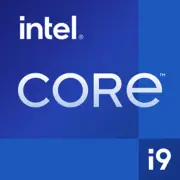Intel Core i9-10920X

Intel Core i9-10920X: A Comprehensive Review of the 2025 Processor
Review for professionals and enthusiasts who value multitasking and performance
1. Key Features: Cascade Lake Architecture and Main Characteristics
The Intel Core i9-10920X, released in 2020, remains relevant in 2025 for niche tasks due to its unique specifications.
- Architecture and Manufacturing Process:
It is based on the Cascade Lake-X microarchitecture with a 14nm manufacturing process. Despite its "age," the 14nm technology provides stability and proven reliability, although it falls short compared to modern 7nm and 5nm solutions in terms of energy efficiency.
- Cores and Threads:
12 cores and 24 threads — ideal for multithreaded tasks. The base clock speed is 3.5 GHz, with turbo boost up to 4.6 GHz (for 1–2 cores). In multithreaded mode, the frequency hovers around 4.1–4.3 GHz.
- Cache and TDP:
L3-cache — 19.25 MB (marketed as 20 MB), TDP — 165 W. This requires serious cooling.
- Key Features:
Support for Intel Turbo Boost Max 3.0, Hyper-Threading, 48 PCIe 3.0 lanes (compared to PCIe 4.0/5.0 from competitors), and hardware protection against Spectre and Meltdown vulnerabilities.
Practical Example: In 2025, users note that the processor performs rendering in Blender at a level comparable to the Ryzen 9 5900X, but falls short in energy consumption.
2. Compatible Motherboards: LGA 2066 Socket and Chipsets
The processor uses the LGA 2066 socket, which limits options to platforms with the Intel X299 chipset.
- Recommended Chipsets:
- X299: The only option that supports multiprocessor configurations (up to 4 GPUs) and overclocking.
- Popular Models of 2025:
- ASUS ROG Rampage VI Extreme Omega (price: ~$350): Support for Wi-Fi 6E, 10Gb Ethernet.
- Gigabyte X299X Designare 10G (~$320): 10-layer PCB, Thunderbolt 3.
Selection Features:
- Ensure that the BIOS is updated to a version that supports Cascade Lake-X.
- Look for motherboards with reinforced VRM (at least 8 phases) for stable overclocking.
Important: New X299 motherboards are scarcely produced in 2025 — most market offerings are leftovers from past batches.
3. Memory Support: DDR4 and Limitations
- Memory Type: Only DDR4 (DDR5 is not supported).
- Frequencies: Officially up to 2933 MHz, but overclocking to 3600–4000 MHz is possible with XMP profiles.
- Configurations:
- 4-channel mode is essential for maximum performance.
- Recommended size: 64 GB (4×16 GB) for work tasks.
Tip: For stability, choose modules with heatsinks, such as G.Skill Trident Z RGB (3600 MHz).
4. Power Supplies: Power Calculation and Recommendations
With a TDP of 165 W and peak power consumption up to 250 W under load, the processor requires a reliable PSU.
- Minimum Power:
- For a single GPU system (e.g., RTX 4070 Ti): 750 W.
- For multiprocessor configurations or multiple GPUs: 1000 W+.
- Recommended Models:
- Corsair RM850x (2025): 80+ Gold, fully modular (~$140).
- Seasonic Prime TX-1000: 80+ Titanium (~$250).
Important: Don’t skimp on the PSU — voltage spikes can damage components.
5. Pros and Cons of Intel Core i9-10920X
Pros:
- High multithreaded performance (Geekbench 6 Multi-Core: 9541).
- Support for 4-channel memory and a large number of PCIe lanes.
- Compatibility with professional software (such as Adobe Premiere, AutoCAD).
Cons:
- High power consumption and heat generation.
- No PCIe 4.0/5.0 and DDR5.
- Price: New processors in 2025 cost $450–500, which is close to the Ryzen 9 7900X ($550).
6. Use Cases: Who is it Suitable For?
- Work Tasks:
- 3D rendering, compositing, virtualization (VMware, Docker).
- Video encoding: HandBrake, DaVinci Resolve.
- Gaming:
- The processor is weaker in single-core performance (Geekbench 6 Single-Core: 1696), so in CPU-dependent games (such as Microsoft Flight Simulator 2024), FPS may drop below 60.
- Optimal for streaming (OBS + gameplay).
- Multimedia:
- Audio processing in FL Studio, editing 8K video.
Example: A production studio uses the i9-10920X paired with the RTX A5000 — rendering a 4K project takes 15% less time compared to the i7-10700K.
7. Comparison with Competitors
- AMD Ryzen 9 5900X (12 cores, $400 in 2025):
- Better in single-core performance (Geekbench 6: ~1950), supports PCIe 4.0.
- Minus: 24 PCIe lanes compared to 48 from Intel.
- Intel Core i7-13700K (16 cores, $420):
- Higher IPC, DDR5 support, but fewer PCIe lanes.
Conclusion: The i9-10920X only outperforms in scenarios where PCIe lanes or 4-channel memory are critical.
8. Practical Assembly Tips
- Cooling:
- Minimum: Noctua NH-D15 (~$100).
- Optimal: Liquid cooling Arctic Liquid Freezer II 360 (~$130).
- Case: Choose models with good ventilation (e.g., Lian Li Lancool III).
- Memory: Use 4 identical DDR4 modules for 4-channel mode.
Hack: Set AVX Offset (-2) in BIOS to lower temperatures under load.
9. Final Conclusion: Who Should Consider the i9-10920X?
This processor is a choice for:
- Professionals already using the X299 platform who want an upgrade without changing the motherboard.
- Enthusiasts who need 48 PCIe 3.0 lanes for multiple GPUs or NVMe drives.
- Studios where stability during long renders is crucial.
Why You Shouldn't Purchase it in 2025?
If you are starting from scratch — it's better to choose Ryzen 7000/8000 or Intel's 13th generation with support for DDR5 and PCIe 5.0.
Price: A new Intel Core i9-10920X in 2025 will cost $480–520, X299 motherboards from $250.
Alternative: A set with Ryzen 9 7900X + B650 motherboard is about $700, but offers upgrade potential.
The i9-10920X is an example of a "morally outdated, yet still combat-ready" solution for specific tasks.
Basic
CPU Specifications
Memory Specifications
GPU Specifications
Miscellaneous
Benchmarks
Compared to Other CPU
Share in social media
Or Link To Us
<a href="https://cputronic.com/cpu/intel-core-i9-10920x" target="_blank">Intel Core i9-10920X</a>